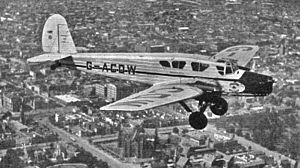Spartan Cruiser
| Cruiser | |
|---|---|

| |
| Spartan Cruiser over Melbourne, 1934 | |
| Role | Light Transport |
| Manufacturer | Spartan Aircraft Limited
|
| Designer | Edgar Percival |
| First flight | 1932 |
| Introduction | 1933 |
| Retired | 1942 |
| Primary users | Spartan Air Lines British Airways Ltd |
| Number built | 17 |
| Developed from | Spartan A.24 Mailplane |
The Spartan Cruiser was a 1930s
Design and development
The Saro-Percival Mailplane was a three-engined monoplane
The Mailplane had produced no commercial interest, so the design was re-worked as a passenger carrier. This was designated the Spartan Cruiser, and the prototype (G-ABTY) first flew in May 1932, piloted by Louis Strange. The original three-engined low-wing layout had been retained, but the plywood fuselage was replaced with an all-metal fuselage to carry six passengers and two crew.[4]
Just one example was built of the basic Cruiser (G-ABTY, later known as the Cruiser I). Both the new Cruiser and the Mailplane were displayed at the first
The Cruiser was re-designed as the Spartan Cruiser II, featuring a modified fuselage and cockpit. The first Cruiser II (G-ACBM) flew in February 1933, powered by
One further development was the Spartan Cruiser III, with an aerodynamically-refined fuselage accommodating eight passengers, a modified windscreen and a trousered main undercarriage. Only three Cruiser IIIs were built (G-ACYK, G-ADEL and G-ADEM), for Spartan Air Lines.[4]
Operational history
Spartan Air Lines Ltd was formed to operate Cruisers between London and Cowes, Isle of Wight. In April 1933, Spartan Air Lines initially operated the one Cruiser I (G-ABTY) and two Cruiser IIs (G-ACDW and G-ACDX) from Heston Aerodrome.[4] Iraq Airwork Limited ordered one aircraft for an experimental air route between Baghdad and Mosul, with a further aircraft being ordered by Misr Airwork, the Egyptian branch of Airwork.[5] Two Cruiser IIs and one Cruiser III were impressed into RAF service in 1940.[4]
Operators
Civil operators
- Bata Shoe Company
- Maharajah of Patiala
- British Airways Limited(1936-1940)
- Northern and Scottish Airways(1936)
- Railway Air Services (1936)[4]
- Scottish Airways (1936-1938)
- Spartan Air Lines (1933-1935)
- United Airways (1934)[11]
Military operators
- Royal Yugoslav Air Force - Two aircraft impressed into military service in 1940.
Surviving aircraft
The fuselage of a Cruiser III (G-ACYK) is on display at the National Museum of Flight, East Fortune, Scotland. This aircraft crashed on 14 January 1938; in 1973, the cabin section was moved by helicopter from the crash site on the Hill of Stake near Largs to the museum.[12][13]
Specifications (Cruiser II)

Data from British Civil Aircraft since 1919 [4]
General characteristics
- Crew: Two
- Capacity: Six passengers
- Length: 39 ft 2 in (11.94 m)
- Wingspan: 54 ft 0 in (16.46 m)
- Height: 10 ft 0 in (3.05 m)
- Wing area: 436 sq ft (40.50 m2)
- Empty weight: 3,650 lb (1,656 kg)
- Max takeoff weight: 6,200 lb (2,812 kg)
- Powerplant: 3 × de Havilland Gipsy Major inverted inline piston engine, 130 hp (97 kW) each
Performance
- Maximum speed: 133 mph (214 km/h, 115.5 kn)
- Cruise speed: 115 mph (185 km/h, 100 kn)
- Range: 310 mi (499 km, 270 nmi)
- Service ceiling: 15,000 ft (4,570 m)
- Rate of climb: 630 ft/min (3.2 m/s)
See also
Aircraft of comparable role, configuration, and era
Notes
- ^ Flight 1933
- ^ Cruiser wing under construction Archived 8 October 2011 at the Wayback Machine
- ^ Flight 10 July 1931
- ^ a b c d e f g h Jackson (1988), pp.188-191.
- ^ a b c Lowe (1994), pp.52-53.
- ^ Yugoslavia - The Aviation Industry at aeroflight.co.uk, Retrieved 4 December 2013
- ^ VT- is the prefix for Indian registered aircraft - in this case the aircraft was owned by His Highness the Maharaja of Patiala
- ^ Image of YU-SAP
- ^ Zmaj Aircraft
- ^ Zmaj aircraft company
- ^ http://www.flightglobal.com/pdfarchive/view/1935/1935%20-%201087.html Flight, 5 May 1935
- ^ "Spartan Cruiser forward fuselage". National Museums Scotland. Retrieved 28 July 2020.
- ^ Stroud (1985), p. 549
References
- The Illustrated Encyclopedia of Aircraft (Part Work 1982-1985). Orbis Publishing.
- Jackson, A.J. (1974). British Civil Aircraft since 1919 Volume 3. London: Putnam. ISBN 0-370-10014-X.
- Jackson, A.J. (1988). British Civil Aircraft since 1919 Volume 3. London: Putnam. ISBN 0-85177-818-6.
- Janić, Čedomir; O. Petrović (2011). Short History of Aviation in Serbia. Beograd: Aerokomunikacije. ISBN 978-86-913973-2-6.
- Lowe, Malcolm V. (1994). "Island Hopper: The Spartan Aircraft Cruiser tri-motor". ISSN 0143-5450.
- "The Spartan Cruiser". flightglobal.com. 22 July 1932.
- Stroud, John (October 1985). "Wings of Peace". Aeroplane Monthly. Vol. 13, no. 10. pp. 545–549. ISSN 0143-7240.
